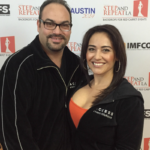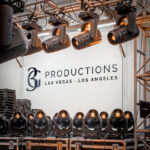The Light Source epitomizes the American family-owned business, fabricating quality original products in their shop in Charlotte, NC. Officially entering their 30th year in business in 2017, they show no sign of slowing down as they continue to fabricate unique items that stem from client needs. PLSN sat down with Eric and Joyce Von Fange to talk about their company.

“Plan Your Work, and Work Your Plan”
Eric met Joyce, his wife of 40 years, in college at Oral Roberts University in Tulsa. They graduated in 1978, settling in Charlotte, NC. From 1984 to 1986, Eric had a fulltime job with another company, but found time to consult part-time in his own business, selling lighting designs and systems, mainly to churches. But by 1987, Eric was working fulltime for himself. Besides the steady growth in the house of worship market, he caught a break when he was hired to design the lighting for The Home Shopping Network at two of their studios in Tampa. “Gene Murphy at Murphy Lighting brought us in. He was a Strand dealer, so I designed a system using the gear he provided.”
“I’ve always made things,” Eric says. “I’ve always walked into stores and asked, ‘I need one of these,’ only to be told that such a product didn’t exist.” He goes on to explain how he got an important lesson from a co-worker named Sam Tolbert, an audio guy at a company he had worked for as a young man. “One day, I walked into the shop, and Sam was building his own 48-way XLR rack. He had designed it himself and was painstakingly building this panel by hand. He had drilled 48 holes that aligned perfectly, as if they’d been done with a machine. I asked him, ‘How did you make something like this so perfect?’ His reply was ‘You just plan your work, and work your plan.’ That one thing can make your work look professional, if you follow it. This man and his words really made a difference in my life.”
The Light Source is well known in the business for their metal craftwork. The company firmly cemented their place in the market when they invented the Mega-Clamp, which became the industry standard theatrical lighting C-clamp. Later, they developed the Mega-Claw, a clamp that needed no tools. The Mega-Claws may have been small in size, but the idea was large and revolutionary. 4Wall actually bought the first silver clamps.
Eric explains how this invention came about. “I had always built something, from a tree fort to whatever, but what really got us started in this world is when I flew to Miami to light the campaign trail, during the Clinton and George Bush era. By chance, I sat down next to an aluminum extrusion salesman. For 90 minutes, we talked about his business, and by the end of the flight, I knew I just had to make something out of extruded aluminum.” About a week later, Von Fange was placing an order for 400 par fixtures. The sales rep told him that if he could make his own C-clamps, he could take seven dollars off the price of each fixture. He realized he could make his own clamp for two bucks and pocket the other five. The seed was sown.
Once designed, he went back to his dealer at L&E and asked how he personally went about ordering C-clamps. The guy explained that he had to buy them in batches of 20,000, a sea container’s worth. Then he had to figure out the precise time to restock his inventory, so he wouldn’t run out. As it turned out, he had just run out of clamps prematurely. “We struck a deal and they bought 480 clamps from us per month, basically forever.”
Another time Eric had a meeting at Disney in Orlando, regarding clamps. Von Fange explains that scenario. “I sat down with the senior safety inspector and showed him the test results on the clamp, as we had had them pull tested to make sure they were strong. He said to me, ‘Look, I want a rated clamp. I want a stamp on here with an 8:1 safety factor and a design load of what this clamp is rated for. If you do that, I will buy them all day long and ban any other clamp from this property.’ Nobody had a rated clamp in those days, so, we added that feature.”

The First Shipment of Black Mega-Clamps
Joyce tells the following story, “It was 1993 and the first shipments of black Mega-Clamps was due at L&E and Times Square Lighting in New York with a drop dead due date of Monday, June 28. As with many new ventures, the path to production had not been without its hiccups. On Saturday, June 26, the issue of the Mega-Clamps had to take a back seat as the Von Fanges gathered in Virginia for the wedding of Eric’s sister.
“Immediately following the wedding, our family dashed back to the Carolinas to deal with the challenge of turning mill finish Mega-Clamps black. Eric made racks for the Mega-Clamps, and our neighbor sprayed them black in his garage. It was convenient to have a neighbor proficient in auto painting. For hours, the building in our backyard resembled a busy beehive as clamps were racked, carried next door for painting, and then brought back to dry beneath the heat of huge quartz television light fixtures. Everyone worked feverishly to get the clamps finished.”
“It was almost 11 o’clock at night when the boxes of clamps, and four tired, sleepy children were loaded into the Suburban. Eric and I took turns driving through the night. At last we arrived in New York, and the very freshly made black Mega-Clamps made their delivery date on time.”

The Lighting Aspect
“My mother tells me my first word was ‘light,’” Eric says. “As a TV lighting director for years, I did lots of concerts, touring and everything else, so lights are in my blood.” he adds. “We were working a project in Tampa around 1990 after Videssence fluorescent lights came out. The 24-hour network we were lighting was concerned with hurricane season, amperage and generator use in case of loss of power. They wanted to use a light source that did not require a whole lot of power, and LEDs weren’t available yet. The Videssence video fixtures were selling for about $7,000 per fixture, and the cost was too much. We were going to lose the job if I couldn’t come up with a fluorescent solution. I found an 85 CRI fluorescent bulb that was reasonable. We made these into 400 pound lights and built them into a huge steel frame, built and wired by Applied Electronics. We had banks of eight 2-by-4-foot lights in these frames and hung several of them in the huge studio. The studio ran at 3000 degrees kelvin, and it looked good on camera.”
A year or two later, the company was contacted by an old friend who was in dire need. He had a client, The Insurance Institute for Highway Safety — those folks who work with crash test dummies. Eric explains, “Fred called me late in the day, heartbroken. He explained that he had been working on a sale for three years and was about to lose it to another company because he did not have actual drawings depicting what was necessary to light this facility. I stayed up all night working out how to do this in CAD. With the full specifications the next morning, the quote was accepted.”
The high-speed cameras in the studio demanded a lot of light. The original plan was for each of these giant light fixtures to be made from 60 1200W par 64s in an 18-by-five-foot frame. In reality, each one was a 72,000-watt light fixture. They had to be able to roll around and take 10 pieces of 2/0 to feed it power. But the bulbs had a 200-hour lifespan to them. They were bright, but changing bulbs constantly would be no fun. An alternative solution was sought. “I scrolled through old Mole Richardson catalogues and found some FFT bulbs designed for cyc lights that threw out the same amount of light from a 1000W bulb. So, I called the client up and said, ‘What if we change the lights to a fixture where the bulbs only cost six bucks each instead of $72 and will last a lot longer?’ They liked the idea.”
The problem was that Eric needed to now build the fixture, and the way he went around it was unique. “Around this time, I had a freshly fallen oak tree from Hurricane Hugo. I drew a parabolic reflector shape and printed it on paper. I took my chain saw and cut out a block of oak and taped the picture on there. Then I bought a band saw and cut around it, shaping one end in a curve. I found you could buy these reflective metal sheets called lighting coil, with different textures. I took a piece of this material and, using a 20-ton H-press, I put the lighting coil in there and pressed it out against the carved oak. It kept the shape, and as long as I had flanges to hold the sideways dimension, I figured it would be fine.
“I made a prototype with a bulb, and it really did work. It made a line of light across the room, which is what they wanted. They didn’t need a rounded light beam, they needed a horizontal one.” Eric added a shell, a socket, some wiring and one big gel frame with Lee 216 diffusion gel. Thus, The Light Source became a lighting manufacturer.

Pendants
Von Fange has gotten some interesting job requests over the years that would require innovative lighting solutions. Back in 2000 was the first time he thought about using LEDs, but they really weren’t powerful enough at that time. But he kept his mind on this technology. One day around 2010, he was looking around on Ebay and he found a 100-watt COB (chip on board) LED and decided to buy a couple to play with. He explains further, “I found a standard theatrical 6-inch diameter Fresnel lens and put the COB element behind it, and it really worked well, equal to a 500-watt Fresnel in quartz. I thought to myself, ‘We could make a good house light with this.’” Thus company’s pendant product line was launched.
“We sold a job with it.” he adds. “But when the first LEDs came in, they had a low-pressure sodium monochromatic orange color — it was horrible. We had a tight deadline getting them made in the first place, so I was stuck. I was fortunate that the colors of the church itself were orange and they weren’t too upset. We went in later and replaced every fixture.”
Eric learned a lesson. He couldn’t trust getting his LEDs from someone he didn’t know in China. Cree, an LED manufacturer was located right up the road in Raleigh, so they turned to them for help. At this point, his company would buy their LED components from Cree and put them onto a copper board and do all kinds of things to keep them consistent. “All of our lights we put out match the exact same consistent color temperature.”
As far as dimming goes, every light they manufacture has an internal dimmer, except for one model. We talked about the trials and errors that came with this. “The first guy I hired to design the dimmer did not understand what I meant when I said the fixture has to be able to dim smoothly. He gave me 0 to 256 steps in a linear way, from off to full (per DMX allowance), and it looked bad, dimming in steps. He said, ‘That’s absolutely all that could be done.’ I went into panic mode, because we had a show coming up, naturally. I told him this will not work, and it is unacceptable. I will not ship this nor show this to anybody. I called a friend to come over. Within 45 minutes we had the fixture running in 14-bit mode with 4096 steps instead of 256, and the dimming was better. Nowadays we have over 1.6 million steps between zero and full.”
They soon abandoned the COB as a light source and developed their own array of LEDS in a tight hex shape or circle, developing their own light engine which is currently being patented. The fixtures are made available in whatever color temperature the client wants. Eventually they came out with an RGBW version of the fixture, but it’s vastly different from everybody else’s fixture.
Eric explains why, “When you utilize just the white LED with the other colors off, you still get the full power of the fixture — 120 watts of natural white light. Or the same with each individual color, so the color punch is amazing. We have gone totally passive with our thermal management. No fans, completely quiet. To maintain that principle, we have installed electronics in our fixture that limit the output. If you wanted to add the red, green and blue LEDs together to get a brighter light output, you cannot, for a reason. We wanted to keep the output wattage consistent. As soon as you add white to an existing color, it automatically starts dimming the colored LEDs to stay within the dedicated wattage. It’s a very smart light.”
Back at the office, it’s very much a family affair. Joyce oversees the artwork, taking pictures and updating catalogues and websites with pertinent info. Siblings of the pair have also gone into the business working alongside the 45 fulltime employees in Charlotte.

Company Snapshot
The Light Source
- Founded: 1984-1986 (side project); 1987 (full time business)
- Founders: Eric and Joyce Von Fange
- Current # Employees: 45
Contact Info:
- The Light Source
- 3935 Westinghouse Blvd.
- Charlotte, NC 28273
- Tel: 704.504.8399
- Web: www.thelightsource.com


